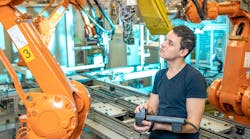While the implementation of robotics and automation can help manufacturers and other types of businesses speed production and drive efficiencies, it doesn’t always have quite the same positive effect on workplace safety. Without question, introducing automation can reduce certain types of worker injuries, such as those typically associated with repetitive upper arm motion and lifting; however, without the appropriate planning, robots and automated processes can also trigger an increase in other types of injuries, including in some instances those with catastrophic consequences.
When properly planned, robotics and automation projects are preceded by a detailed ergonomics analysis or completed improvement project to justify the investment. Yet, in some situations where automation was designed to reduce one type of risk, it has a problematic side-effect of introducing new risk factors that weren’t originally anticipated.
In an environment where automation often will be essential to achieving efficient increases in domestic production, operations executives need to be able to anticipate the variety of new tasks that may be required of employees following the installation of robots or other types of process automation. They also need to be able to assess any new risks to employees associated with their changing roles.
For instance, even when positions involving repetitive and non-complex jobs are replaced by automation, the employees may move into new roles that are not only highly repetitive, but also more complicated or even physically strenuous to perform or monotonous. This could lead to increases in work-related musculoskeletal disorders (WMSDs), mental fatigue, higher error rates, and a deterioration of overall quality.
Certainly, those who have done a thorough job on the ergonomics assessment prior to implementing automation should know not only what types of risks the automation will likely eliminate, but also any significant new exposures that might come into play. By using more objective data, such as that obtained through the use of wearables, these pre-assessments might yield more insights on any new workplace exposures arising from automation that employee safety practices will need to address.
Here are some proven measures for executives in operations, engineering, and IT to gain a more complete understanding of any new or unaddressed automation-related risks that organizations should flag and work to mitigate ideally prior to the implementation of robotics and any other process automation.
1. Understand the rationale for investing in automation. Businesses typically invest in automation for several different reasons. They include: replacing certain types of highly repetitive or dangerous tasks to reduce employee injuries or prevent specific health issues; creating efficiencies by eliminating positions where a computed algorithm can make decisions (such as those involving certain types of financial transactions or those associated with automated call processing centers); operational functions where many basic job tasks might be combined to achieve an overall reduction in labor costs.
2. Consider the impact of AI-driven software on employees. Some AI software systems can track personal productivity and provide feedback to supervisors on how to improve their performance. In some respects,, the outcome may be that your employees now have software with AI as their “new supervisor.” Unfortunately, while these scenarios may yield short-term boosts in productivity, they also may require workers to perform with higher rates of repetition, fewer micro-breaks, and less perceived control over the process. The result: an increase in WMSDs and work-related stress issues.
3. Use wearables selectively to flag potential physical hazards. Avoiding these types of outcomes calls for going beyond standard observational risk assessments and conducting more advanced evaluations of an individual employee's responses to physical work requirements. For example, the use of the latest generation of wearables, such as a surface electromyogram(sEMG), allows ergonomists to measure muscle activity and identify potential fatigue. In addition, IMU (inertial measurement units) sensors can track body movements, such as posture, speed, and acceleration, that may be increasing the internal forces on the body, leading to a higher probability of injury. Additionally, monitoring heart rate can help measure energy expenditure to ensure the activity is not causing overall muscle fatigue.
4. Evaluate specific worker tasks automation will replace. Determine the type of jobs or task characteristics new robotics and automation will take on. Are they highly routine type activities, repetitive in nature, or those where high quality can be maintained through standard tasks? From an ergonomics and injury perspective, these tasks typically have high rates of repetition related to postural deviations and potentially high force or muscle effort that can lead to discomfort, fatigue, and potential WMSDs. In practice, these situations might apply both to basic manufacturing assembly tasks as well as office jobs.
5. Determine what low-risk work automation will eliminate and its impact. In addition to the automation of more hazardous physical work, be sure to assess the types of jobs or task characteristics related to the lower risk tasks that will be eliminated through automation. Do they require a high degree of manual dexterity, such as involving asymmetric parts that call for visual processing and decision-making to manipulate and fit into an assembly? Do they include complex decision-making tasks that require judgment or even creativity to perform? Are they work tasks that require multiple people and collaborative decision-making on public safety matters (such as aircraft piloted by humans versus drones).
6. Develop training modules to help employees safely adjust to new roles. While automated systems can help plants meet and sustain elevated productivity and quality standards, they also free up human capital to focus on complementary value-added tasks, such as quality inspections. Nonetheless, they may create different types of safety and health issues for workers designated to operate new machinery or continuing their current roles alongside new robots taking on parallel tasks.
7. Carefully assess factory floor design and spatial relationships. A critical issue with automation involves failing to allocate sufficient space for humans and automation to co-exist. Consider using advanced human CAD computer programs that facilitate the 3D design of work areas where virtual employees could be placed in spaces designated for installation of automation or robotics to test space, reach, sightlines, other visual interactions, and potentially hazardous blind spots. In addition, be sure designs enable access to critical mechanical locations so maintenance and repair staff will have appropriate, safe, and ready access.
Even though enthusiasm over automation and robotics has steadily increased in recent years, the impact of the COVID-19 pandemic has elevated the discussion among manufacturers to find new ways to ramp up domestic production. As their enterprises respond to the challenge by expanding their use of automation, they need to sharpen their focus on how these investments will impact worker safety and health. By taking steps in advance to understand the potential benefits and carefully assess the risks associated with automation, manufacturers will be positioned to maximize the productivity, performance, and sustainability of these initiatives.
Scott Smith is director of ergonomics for Aon Risk Solutions.




